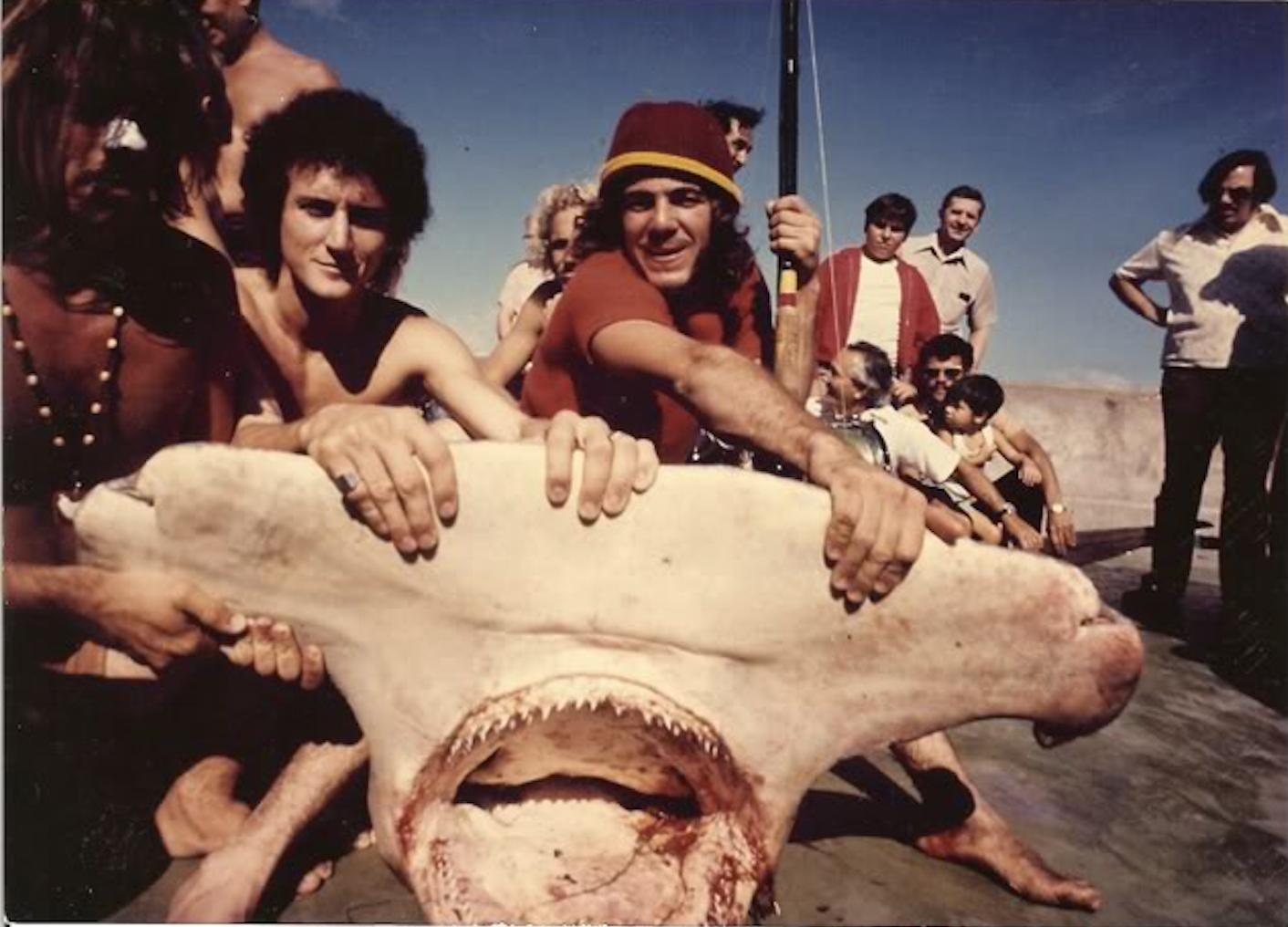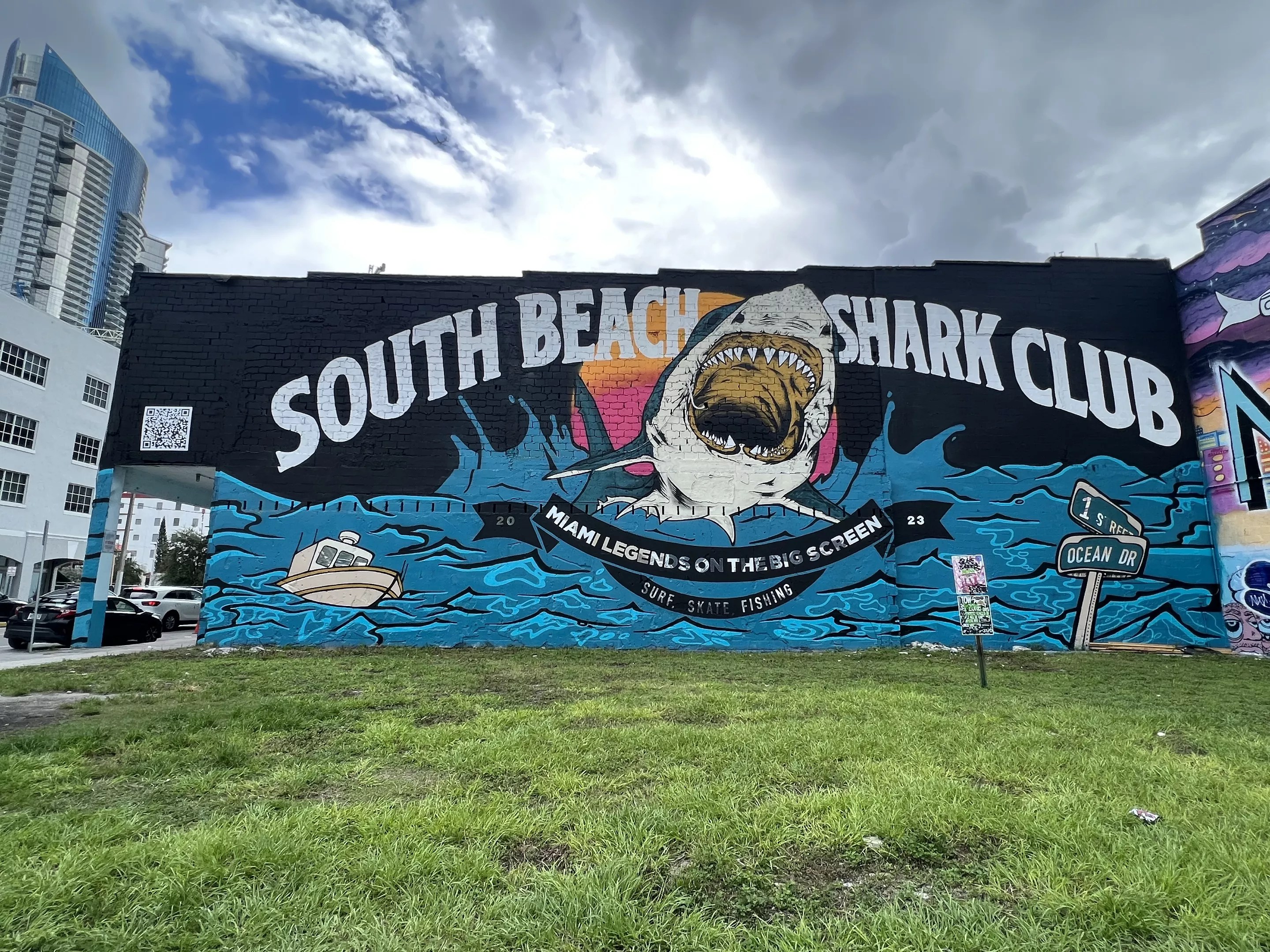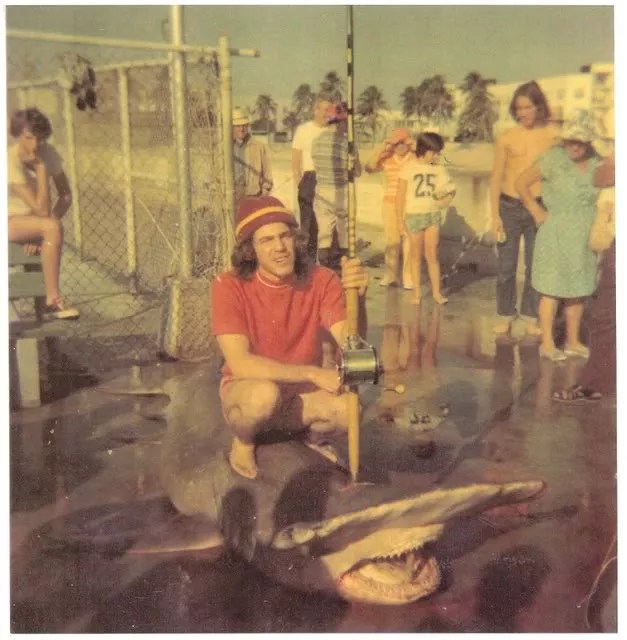
William Fundora photo

Audio By Carbonatix
The great white shark is frozen in midair. The hook planted firmly in his jaw has the creature opened up, saying “Ahhhhh!” to anyone walking by. The mango-colored sunset over its shoulder resembles a halo. To the left of this holy shark is a QR code the size of a boogie board.
This 60-foot mural is part of the guerrilla-marketing campaign for the feature-length documentary South Beach Shark Club: Legends and Lore of the Miami Beach Shark Hunters. The film is a deep dive into the shark fishing scene that started in South Beach in the 1970s, which resembled California’s skate scene in the same era – just swap boards with fishing rods.
Director Robert Requejo Ramos and producer Pedro Gomez, the 30-something filmmakers behind the doc, have a smoke while looking up at their creation on the corner of NW 11th Street and North Miami Avenue.
“We could take out a billboard, we could fly a plane, we could do stuff like that, but why not just come out here and do something in the street where people are going to pass by right on the actual corner?” Requejo Ramos says.
“It’s something more part of the community than a billboard or a plane would be,” Gomez adds.
The building’s owner, a friend of a friend of Ramos, approved the usage of his wall on June 9. This gave Requejo Ramos and Gomez 11 days to execute a mural for the film’s digital release on June 20, the 48th anniversary of Steven Spielberg’s Jaws.
“We brought a whole community of artists together from the designers to the painters to laborers to just people coming up with ideas,” says Requejo Ramos, pointing out the real-life gargantuan hook hanging from the shark’s lip. “My buddy who’s a welder saw what we were doing and said, ‘I wanna be a part of that,’ so he went and welded that. Next day he came with a chain and put an actual hook in the mouth.”
The mural itself represents the process of putting together the actual movie it’s meant to promote: a labor-intensive slog with a shoestring budget.
“A lot of people came out here without getting paid for this. It was just materials and rentals for stuff,” Requejo Ramos says. “You need all those elements to fall together for something like this to happen.”
Curiously, the duo must go to these lengths to promote the film. On its surface, South Beach Shark Club has the makings of a hit streaming documentary. Archival footage of a not-too-distant yet bygone era? Check. The rise and fall of a charismatic leader? Check. Groovy 1970s athleisure fits? Check.
But problems came when searching for a distributor. Producers and agents wanted the pair to make changes to modernize the film, making it more desirable for distribution. However, Requejo Ramos and Gomez didn’t want the film to get lost in the documentary industrial complex that seemingly churns out the same types of nonfiction narratives month after month.
“A lot of these films coming out, especially documentaries feel so formulaic,” Gomez explains. “These suggestions felt like we were going to be part of the conveyor belt than be our own thing.”
Notes on the politics of shark hunting and conservation, which the filmmakers admit are valid, didn’t have a place in the story they wanted to tell. As they put it, they didn’t want to talk politics or religion at the dinner table. This was a story about family and tradition.

The mural by GUK and Nine & Eye promotes the on-demand release of South Beach Shark Club.
Photo by Nicholas Olivera
What’s more, Requejo Ramos and Gomez didn’t set out to make a documentary. They wanted to tell a fairy tale about shark fishing in Miami.
“I quite literally told these stories as a child, almost like a fairy tale, so we wanted to take that perspective of telling a legend and structuring the story that way too,” Requejo Ramos says. “That’s what ruled those editing decisions and storytelling decisions, not veer from the characters or veer from the legend itself.”
Would the myth of Prometheus stealing fire from the gods be as effective if there was a 15-minute tangent about California forest fires? Probably not.
“In a fable, you have these lessons that you learn, kind of like the Aesop’s fables, and I think the lesson that you learn with Rene is that,” Requejo Ramos adds. “It’s a warning about being obsessed.”
Requejo Ramos refers to Rene de Dios, the charismatic shark fisherman who became the frontman of the scene in the 1970s. He was a media darling, appearing on local talk shows and even gracing the pages of the Miami Herald. De Dios’ story arc turns this documentary into a mythical tragedy.
“He was the greatest shark hunter in the United States, but he died proving it,” Gomez says, quoting one of the talking head interviews from the film. “We put a cloud over the way that he died to keep you in suspense. Did this guy get eaten by a shark? What happened?”
Ultimately, Requejo Ramos and Gomez stuck to their guns, telling the story they wanted to tell and how they saw fit. They got into filmmaking to work on narratives, not docu-dramas.

Rene de Dios is pictured with a hammerhead shark.
William Fundora photo
“We’re not documentary filmmakers or anything like that,” Gomez explains. “We always wanted to do narrative. David Lynch, the Coen brothers have always been our favorite filmmakers.”
As fate would have it, the pair had a chance encounter with a figure whose fanbase obsesses over his own mythic presence – someone who has worked with both Lynch and the Coens: Nicolas Cage.
“He [spoke] at Miami Dade College back in March, and apparently, he showed some interest in the archeological site along the Miami River,” Requejo Ramos says. “Pedro and I got to hang out with him for about 15 minutes in the back of a Mercedes Sprinter van.”
In the end, the filmmakers are happy with the final product. What’s on the screen is the story they needed to tell with no compromises.
“I always say the edit is talking to me or the story is talking to me,” Requejo Ramos says. “Once you lay out all the cards on the table, it’s like reading a tarot. It tells you what to do. That’s kind of what we try to tap into.”
South Beach Shark Club: Legends and Lore of the Miami Beach Shark Hunters is available on-demand at Amazon, iTunes, Vudu, Vimeo, Google Play, and YouTube.